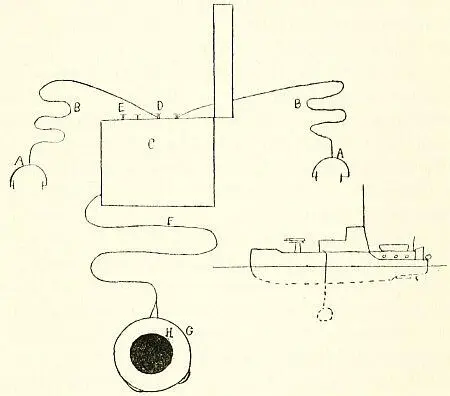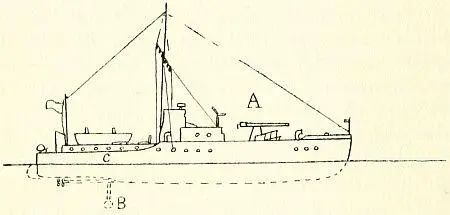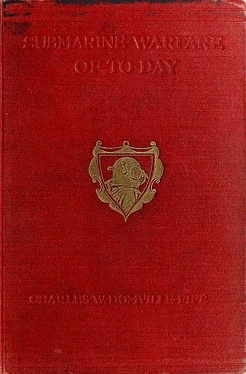In addition to all these types of anti-submarine craft there were, forming part of the auxiliary fleet, over 300 ships, mostly trawlers and drifters, engaged in maintaining the great lines of boom defences, closing vast stretches of sheltered waters frequented by the battle fleets, and a considerable number of examination ships, staffed by interpreter officers, whose duty it was to examine all neutral shipping passing through the 10,000 miles of the blockade.
These, then, were the ships of the new navy, and their formation into flotillas, or units, was usually accomplished by grouping four or five vessels of similar type together under the command of the senior officer afloat—mostly a lieutenant R.N.R. or R.N.V.R. In the case of minesweepers the unit nearly always consisted of an even number of ships, because their work was carried out in pairs, and with M.L.’s it usually consisted of five boats, as this was the number required for the intricate tactical work of submarine chasing.
There were, of course, units from the United States, French, Japanese, Italian and Brazilian navies, in addition to the formidable British armada.
The auxiliary units were all based on one or other of the fifty odd war stations which encompassed not only the coasts of Great Britain and Ireland, but also the littoral of every land in our world-wide Empire. The numbers given here do not include the local fleets of purely colonial naval bases, nor the large flotillas of destroyers and “P” boats operating in home and foreign waters in conjunction with the auxiliary navy. If these were incorporated the anti-submarine fleets would be almost doubled.
Now that the reader is familiar with the raison d’être of the new navy, the personnel, the ships and their formation into fleets, the scope and limitations of their activity, and of the losses they sustained, the way is clear for a description of the curious weapons used, the mysteries of anti-submarine warfare, and the bases themselves before entering the zone of war and seeing something of the actual work of the auxiliary navy.
CHAPTER V
The Hydrophone and the Depth Charge
Of all the weapons used in the anti-submarine war the two most important were the hydrophone and the depth charge . They were employed in conjunction with each other and comprised the surface warship’s principal means of offence against submarines operating beneath the surface.
The hydrophone resembles a delicate telephone. It is so constructed that when the instrument is lowered over the side of a ship into the sea any noise, such as the movement of a submarine’s propellers, can be heard on deck by an operator listening at an ordinary telephone receiver connected to the submerged microphone by an electrified wire.
There were many different types of hydrophone in use during the Great War. So important was this instrument for the work of submarine hunting that money was spent in millions, and a corps of naval and civil experts were engaged for several years, bringing it to a state of efficiency. Each type introduced into the Service was an improvement on its predecessor, and there were different patterns for the use of almost each class of vessel. The fast destroyer required a different instrument to the slow-moving trawler. The motor launch could only employ successfully a totally different type to the submarine, and, to add to the difficulties, the German submarines themselves were generously supplied with similar instruments. The games of “hide-and-seek” played on and under the seas with the aid of this wonderful little instrument would have been distinctly amusing had men’s lives—and often those of women and children—not been dependent upon the issue.
The portable hydrophone, used by some of the smaller and slower vessels of the auxiliary fleet, consisted of a microphone, or delicate mechanical ear, carefully guarded by metal discs from accidental damage, and connected to ear-pieces or ordinary telephone receivers by an electric wire which passed through a battery. Where the wire came in contact with the sea water it was heavily insulated and lightly armoured.
When it was required to use this instrument the vessel was stopped and the microphone lowered overboard to a depth of about 20 feet. This was the distance down from the surface at which submarine noises could be heard most distinctly. The operator on deck or in the cabin then adjusted the ear-pieces and sat listening for any noises coming through the water. Although the sea is a far better conductor than air, the range at which sounds could be heard varied considerably. On a calm day or night the noise of a ship’s propellers could frequently be distinguished at from five to seven miles; whereas on a rough day, with the sea splashing and the wind roaring, it was often difficult to hear anything beyond half-a-mile.

Fig. 6.—Diagram showing essential parts of a portable hydrophone. A. Head and ear pieces, by means of which a trained listener hears submarine sounds. B. Flexible leads to enable an officer to verify reports from listener. C. Battery box, containing spare set of cells. D. Terminals. E. Terminals of spare cells. F. Flexible armoured electric cable which is lowered over side of ship. G. Metal case protecting the microphone H . H. Microphone or delicate receiver of submarine sounds, which is submerged (when required, but not when ship is moving) to a depth of about 18 feet, as in small diagram. The sound is detected by the microphone and transmitted up the cable F and wires B to the ear-pieces A .
In fine weather a submarine could usually be heard at a distance of about two or three miles. There were, however, many microscopic noises of the under-seas which were picked up and magnified by this type of hydrophone. They were called “water noises,” and often made it extremely difficult to differentiate between them and the sound of a moving submarine at a great distance. Later types were not so prone to these disturbing influences.
To describe here the different natural and artificial noises heard on a portable hydrophone is extremely difficult. One general statement can, however, be made. It is the noise caused by the rapidly revolving propellers of both surface ships and submarines that is the guiding factor in the work of detection by submarine sound. A destroyer travelling at full speed on a calm sea, when heard on a hydrophone resembles the roar of a gigantic dynamo. The sound does not alter as the distance between the stationary listening ship and the fast-moving warship increases or decreases; it continues to be a roar or low hum, according to distance, until it fades out of hearing altogether. The same statement applies also to a slow-moving cargo steamer, only in this case the single propeller is revolving very much slower, and, when listening on a hydrophone about two or three miles distant, each successive beat of the engines can be distinctly heard.
The simple movement of a vessel’s hull through the water cannot be heard on a hydrophone. Therefore for detecting the presence in the vicinity of a sailing ship at night or in a thick fog this instrument is quite useless. The same drawback applies also to the location of a floating derelict or iceberg, and restricts the use of the hydrophone to faithfully reporting the presence of power-driven ships or special sound signals at a range of a few miles.

Fig. 7.—An improved directional hydrophone fitted through keel of motor launch. The tube B , at the lower extremity of which is the microphone, can be raised or lowered from C , the cabin of the M.L. This instrument is so arranged that the direction from which the submarine sound is coming can be simply and quickly ascertained.
A German submarine heard at a range of about a mile on a calm night presents a curious sound which almost defies description. Its principal constituent consists of a “clankety clank! clankety clank!” at first barely distinguishable from the low swish of the water past the face of the submerged microphone, then louder when the sound has been distinguished and the human ear is on the alert. But when this sound was heard in war there was little time for analysing or noting. It was the call to action. The microphone was hauled to the surface and the chase began, a halt being made every half-mile or so for a further period of listening on the hydrophone. If the sound was louder the commander of the pursuing vessel knew that he was on the right track, and if the sound came up from the sea more indistinct the course was changed and a run of a mile made in the opposite direction, when the vessel was again stopped and the instrument dropped overboard.
Читать дальше














